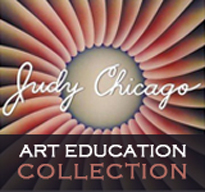![]()
Constance Bumgarner Gee, TTF’s Education Committee Chair
 Through the Flower and the entire Dinner Party Curriculum team thank you for your interest in this project. We are glad to have you with us on this journey into a history that was written by many able contributors and then erased systemically, on purpose and in ignorance. It is the history of 1,038 religious and state leaders, scholars, orators, scientists, philosophers, artists, authors, musicians’a story of gifted intellect, courageous acts, indomitable spirit. What we offer to you, and what we hope you will take, remake, and offer in turn, is the unfolding story of the proud achievements of women in days past and present, an inspiring narrative of profound relevance for women and men, now and for the future.
Through the Flower and the entire Dinner Party Curriculum team thank you for your interest in this project. We are glad to have you with us on this journey into a history that was written by many able contributors and then erased systemically, on purpose and in ignorance. It is the history of 1,038 religious and state leaders, scholars, orators, scientists, philosophers, artists, authors, musicians’a story of gifted intellect, courageous acts, indomitable spirit. What we offer to you, and what we hope you will take, remake, and offer in turn, is the unfolding story of the proud achievements of women in days past and present, an inspiring narrative of profound relevance for women and men, now and for the future.
For all the bad news we hear about K-12 education in the United States, there has been much good work in curricula development in the liberal arts and sciences focused on deep inquiry into overarching “big ideas” and “essential questions” that comprise the rich content of human experience and endeavor. University visual arts educators and their colleagues in K-12 art classrooms across the country have played a leading if largely unacknowledged role in the creation and furtherance of such content- or inquiry-based teaching and learning. Since the mid-1960s and with little support from the larger education community, art educators working within and on behalf of elementary through secondary education have developed genuinely interactive methods to engage young people in the exploration of the visual arts and their inextricable expression of human triumph and tragedy, of intellect, perception, and emotion.
 The study of art aligns naturally with the important goal of bridging subject areas to deepen our own and our students’ understanding of the profound interconnectedness of peoples, ideas, places, and actions. It is not easy to teach in this manner; ongoing research, study, and practice are required. Yet it is essential that we do our best because this kind of comprehensive schooling is what makes past discoveries, concerns, and events meaningful to children today and relevant for tomorrow.
The study of art aligns naturally with the important goal of bridging subject areas to deepen our own and our students’ understanding of the profound interconnectedness of peoples, ideas, places, and actions. It is not easy to teach in this manner; ongoing research, study, and practice are required. Yet it is essential that we do our best because this kind of comprehensive schooling is what makes past discoveries, concerns, and events meaningful to children today and relevant for tomorrow.
The Dinner Party as process and entity exemplifies this breadth and depth of inquiry and interconnectivity. It functions on many levels and across intellectual and expressive domains. The Dinner Party beckons all to a table where lively conversations of history, art, literature, and science are held amidst beautifully woven tapestry, intricate needlework, golden-glazed porcelain, and luminous china. It is a feast of the mind and the senses, a portal through the sensate flower of human consciousness, creation, and expression. It stands as a heartening example of what can be brought into existence when women and men work together in earnest and on behalf of something larger than themselves.
 There are times when self-absorption and cynicism seem to be the defining characteristics of our Western culture. Certainly both have been in abundant evidence within the contemporary art world itself. The Dinner Party offers a nourishing antidote for self-absorption and cynicism as it is about the recognition and celebration of the achievements of others. It does not look inward but outward. It lifts up rather than tears apart. There is no sarcasm. These are lessons and dispositions worth learning, practicing, and passing on. The purpose of The Dinner Party Curriculum is to do just that by bringing more people together to deepen and sustain the conversation about women’s achievements past and present. The intention is to inspire among young women and men wonderment and gratitude, and a sense that they too can do something important and be remembered for it.
There are times when self-absorption and cynicism seem to be the defining characteristics of our Western culture. Certainly both have been in abundant evidence within the contemporary art world itself. The Dinner Party offers a nourishing antidote for self-absorption and cynicism as it is about the recognition and celebration of the achievements of others. It does not look inward but outward. It lifts up rather than tears apart. There is no sarcasm. These are lessons and dispositions worth learning, practicing, and passing on. The purpose of The Dinner Party Curriculum is to do just that by bringing more people together to deepen and sustain the conversation about women’s achievements past and present. The intention is to inspire among young women and men wonderment and gratitude, and a sense that they too can do something important and be remembered for it.
I am grateful for the excellent work and selfless dedication of all those who have contributed to the development of The Dinner Party Curriculum, most especially professors Marilyn Stewart, Project Director, Peg Speirs, and Carrie Nordlund of Kutztown University.
I am grateful to Judy Chicago for her vision, damnable insistence, and lioness heart. All are true heroines with an honored place at the table. But we are most grateful to the elementary, middle school, and secondary teachers who, along with their students, will write the next chapter of The Dinner Party.
Constance Bumgarner Gee, Ph.D.
Associate Professor of Public Policy and Education
Vanderbilt University

